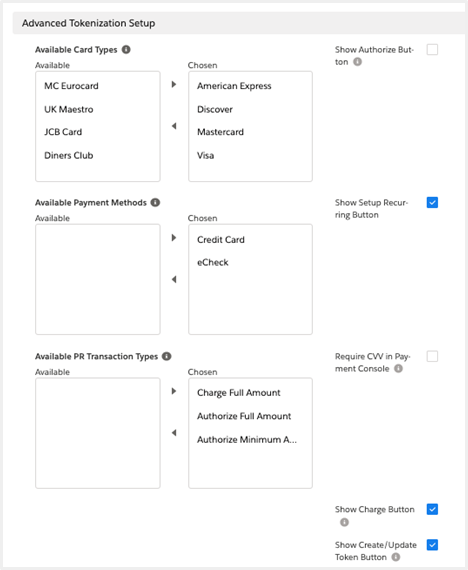Chargent’s Payment Console feature allows you to process one-time payments and recurring payments directly from the Chargent Anywhere component, which can be configured on just about any object in Salesforce, standard or custom. This makes it a convenient interface for call center agents, customer service, billing, or sales teams since it is able to initiate payments, receive tokens back from the payment gateway, and create transaction records in Salesforce.
Note: Payment Console is only available to Platform and Enterprise Edition customers. For more information, see our Pricing Page.
Transactions and tokens are created with the Payment Console feature without ever saving or storing cardholder account number information in Salesforce. If the Payment Methods feature is enabled, you can select from saved cards or bank accounts without viewing or exposing sensitive payment information. This helps you reduce the scope of your PCI compliance while making it easier for your staff and customers to make payments.
Setting Up Payment Console #
Activating Payment Console
When you set up your first payment gateway using the Gateway Setup Wizard, Chargent prompts you to enable the Payment Console feature. When you select Yes, an email requesting an activation key is sent to Chargent’s support team, who will review your request and send your key as soon as possible. Once you receive the activation key, copy it to your clipboard and enter it into Salesforce.
For more information about Activating the Payment Console, see Feature Activation.
Configuring Payment Console
Now that you’ve activated the Payment Console, you can find a few additional configuration options on your Gateway record and in the Chargent Anywhere component’s configuration. You can also add additional functionality to the Payment Console by activating Payment Methods.
Gateway Settings
When setting up your initial gateway, you will configure various settings related to the Payment Console, including the buttons you want to display and the types of credit cards and bank accounts you accept. These settings are modifiable, and you can always visit your Gateway record to update them.
To modify these settings:
- Click the App Launcher icon
and select Gateways.
- Click the name of the Gateway record you want to update.
- Click Edit.
- Click Advanced Settings.
The following fields control the behavior of the Payment Console:
- Available Card Types: Visa, MasterCard, American Express, etc…
- Available Payment Methods: Credit Cards and/or Bank Account (ACH, eCheck, Direct Debit)
- Payment Buttons: Authorize, Charge, Update Token, and Show Setup Recurring
- Require CVV: This setting requires the CVV / CVV2 security code in the Payment Console. This is the 3-digit code on the back of the credit card. It will be either 3 digits for Visa and MasterCard or 4 digits for American Express.

Every gateway offers a different set of features and capabilities. For more information regarding your Payment Gateway settings, please check out the documentation specific to your gateway.
Chargent Anywhere Settings
The remaining settings related to the Payment Console are located in the Chargent Anywhere component’s configuration.
To access the various configuration options, follow these steps:
- Navigate to a record with Chargent Anywhere.
- Click the gear icon and select Edit Page
- Select the Chargent Anywhere Lightning Component.
- If you haven’t added Chargent Anywhere to your Lightning Page, drag the component to your page from the left sidebar under Custom – Managed.
For more details about the Chargent Anywhere component configuration fields, visit Customizing Chargent Anywhere.
Using The Payment Console #
The Payment Console button appears in the Chargent Anywhere component, which you can add to any object in Salesforce. See the instructions below to learn how to take one-time or recurring payments using the Payment Console.

Processing One-Time Payments
- When a user clicks Payment Console, a window displays, prompting them to enter the customer’s billing information, including name, address, and email.

- If Payment Methods is activated in your org, users can select an existing Payment Method record filtered according to the Chargent Payment Methods Search Layout. For more information, see Payment Methods for Payment Console.
- Click Continue to enter the remaining payment details.
- For one-time payments, select One Time and enter the remaining payment details, such as the customer’s credit card or bank account number. The Amount field can be automatically populated if set up via the Chargent Anywhere component configuration. Click Charge to automatically create a Chargent Order record and send a callout to your gateway.
Note: You can also use the Payment Console to create an authorization. For more information about authorizations, see Understanding Payments.
- If the transaction was successful, a green approval window displays and a transaction record is created. If the transaction is unsuccessful, a red message displays, showing a decline or error, and a transaction record is created with the decline reason.

Processing Recurring Payments
- When a user clicks Payment Console, a window displays, prompting them to enter the customer’s billing information, including name, address, and email.

- If Payment Methods is activated in your org, users can select an existing Payment Method record filtered according to the Chargent Payment Methods Search Layout. For more information, see Payment Methods for Payment Console.
- Click Continue to enter the remaining payment details.
- Click Recurring to generate a recurring payment. First, enter the remaining payment details, such as the customer’s credit card or bank account number. If set up using the Chargent Anywhere component configuration, the Initial Amount and Recurring Amount fields can be automatically populated.
- Next, you have the option to add an Initial Amount, reflecting an immediate charge or authorization (such as a fee or downpayment). The value for the Recurring Amount is required and will be charged on your Payment Start Date, chosen in the next step.
- Click Next.
Note: If a recurring payment has already been created for a specific record, you can update it by updating the payment details and clicking Update Recurring. When you click Stop Recurring, Chargent changes the Stop Rule on the related Chargent Order and adds a Payment End Date when needed.
- Click Next to review the recurring payment details. For a list of recurring field descriptions, see Recurring Billing.
- Click Next to display a list of payments in the schedule or Previous to make payment detail changes. Click Payment Details to return to the payment settings page.
- Click Start Recurring Billing to create a new Chargent Order and schedule the recurring payment. If you choose to add an Initial Amount, a callout to your gateway is made and a Transaction record is created.
- If the transaction is successful, a green approval window displays. If the transaction is unsuccessful, a red message displays, showing the decline or error, and a transaction record is created with the decline reason.

See Also
Chargent Anywhere
Setting Up Payment Methods
Understanding Payments




